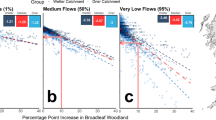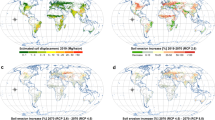Abstract
INTERNATIONAL efforts to control the emissions of the acidifying compounds SO2 and NOx to the atmosphere, and to establish critical loads, are in part aimed at predicting the long-term response of soils and waters to changes in acid deposition. Estimation of future long-term trends in acidification requires the use of models, the strict verification of which requires years or decades to determine whether predictions match observed responses. Experimental manipulations with whole ecosystems provide data with which predictive models can be evaluated. The MAGIC model1,2 is a widely used, intermediate-complexity, process-oriented model for soil and water acidification in catchments. Here we follow up a preliminary application3of the model to the first two years of data from the manipulated catchments of the RAIN (Reversible Acidification In Norway) project4. We use a more extensive four-year data set as inputs to a new version of the model. The four-year record provides a much more rigorous test of the predictive ability of the model because these data show major changes in runoff chemistry due to the experimental change in deposition. Sensitivity analysis shows that MAGIC is successful at predicting future acidification.
This is a preview of subscription content, access via your institution
Access options
Subscribe to this journal
Receive 51 print issues and online access
$199.00 per year
only $3.90 per issue
Buy this article
- Purchase on Springer Link
- Instant access to full article PDF
Prices may be subject to local taxes which are calculated during checkout
Similar content being viewed by others
References
Cosby, G. J. et al. Wat. Resour. Res. 21, 51–63 (1985).
Cosby, G. J. et al. Wat. Resour. Res. 21, 1591–1601 (1985).
Wright, R. F. & Cosby, B. J. Atmos. Envir. 21, 727–730 (1987).
Wright, R. F. et al. Nature 334, 670–675 (1988).
Lotse, E. & Otabbong, E. Acid Rain Res. Rep. 8/85 (Norwegian Institute for Water Research, Oslo, 1985).
Lotse, E. Acid Rain Res. Rep. 18/89 (Norwegian Institute for Water Research, Oslo, 1989).
Bettelheim, J. & Littler, A. CEGB Rep. PL-GS/E/1/79 (Central Elect. Generating Board, London, 1979).
Wright, R. F. et al. Nature 334, 422–424 (1988).
Frogner, T. Geochim. cosmochim. Acta (in the press).
Wright, R. F. Wat Air Soil Pollut. (in the press).
Wright, R. F. et al. Wat. Air Soil Pollut 30, 367–380 (1986).
Neal, C. et al. Nature 334, 109–110 (1988).
Hornberger, G. M., Cosby, B. J. & Wright, R. F. Wat. Resour. Res. 25, 2009–2018 (1989).
Author information
Authors and Affiliations
Rights and permissions
About this article
Cite this article
Wright, R., Cosby, B., Flaten, M. et al. Evaluation of an acidification model with data from manipulated catchments in Norway. Nature 343, 53–55 (1990). https://doi.org/10.1038/343053a0
Received:
Accepted:
Issue Date:
DOI: https://doi.org/10.1038/343053a0
This article is cited by
-
Acidification and Prognosis for Future Recovery of Acid-Sensitive Streams in the Southern Blue Ridge Province
Water, Air, & Soil Pollution (2011)
-
Improving the vegetation dynamic simulation in a land surface model by using a statistical-dynamic canopy interception scheme
Advances in Atmospheric Sciences (2008)
-
Deposition pattern of precipitation and throughfall in a subtropical evergreen forest in south-central China
Journal of Forest Research (2006)
-
Experimental acidification of alpine catchments at Sogndal, Norway: Results after 8 years
Water, Air, & Soil Pollution (1994)
-
Simulating acidification and recovery processes in experimental catchments with the ILWAS model
Water, Air, and Soil Pollution (1994)
Comments
By submitting a comment you agree to abide by our Terms and Community Guidelines. If you find something abusive or that does not comply with our terms or guidelines please flag it as inappropriate.



